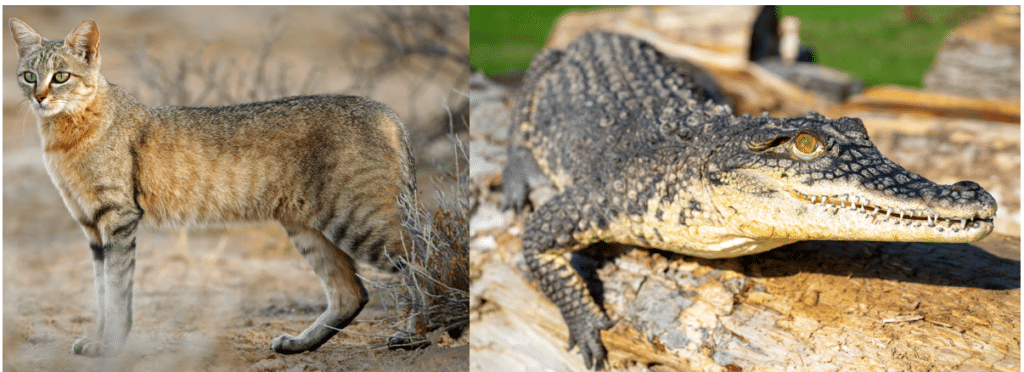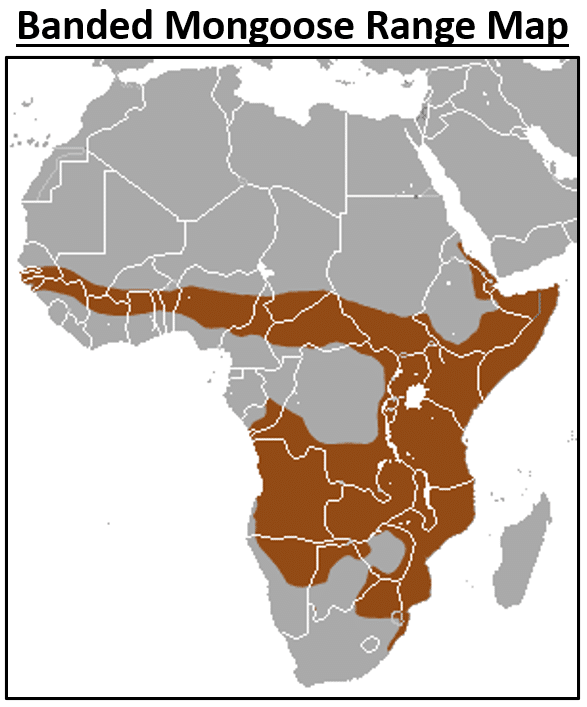7 Fierce PREDATORS found in Rwanda! (2025)
What are the different kinds of PREDATORS found in Rwanda?

These are often the first animals you think of when you imagine visiting Rwanda! The exciting, beautiful, and sometimes terrifying carnivores are some of the most fun to learn about. 🙂
In this article, you’ll find interesting facts, photos, and even range maps of these amazing animals!
7 Predators Found in Rwanda:
#1. Lion
- Panthera leo

Identifying Characteristics:
- Adults are 160-208 cm (63-82 in) long.
- They have short tawny coats, white undersides, and long tails with black tufts at the ends.
- Males have manes, while females do not.
These predators range throughout savannas and plains in Rwanda.
They prefer areas with plenty of cover and prey. In the past, lions had a much larger range, and some populations still live in semi-desert, forested, shrubby, and mountainous habitats.
Though intimidating, lions aren’t very effective hunters on their own. Instead, lions usually hunt in groups, called prides, to take down large herbivores like zebras, impalas, gazelles, wildebeests, giraffes, and cape buffalo.
Lions live in groups called prides which range from 2-40 individuals, though they are rarely all together at once. Female pride members are all related, as females don’t leave their mother’s territories. Females don’t have a dominance hierarchy and instead work together to find food and care for each other’s cubs.
On the other hand, males are generally forced out of their father’s territory at about 2.5 years of age, roam for two to three years, and then attempt to take over a pride by seriously injuring or killing the current leaders and their cubs. While we often picture one male as the “king,” male lions sometimes form coalitions of 2-4 males to take over a pride. These coalitions are often brothers, and the larger the coalition, the longer they’ll be able to reign over their pride.

While they don’t have natural predators, lions are still susceptible to starvation and attacks from humans. Their worldwide populations have declined significantly throughout their range. Sadly, some subspecies of lions are critically endangered, and some are already extinct.
#2. Leopard
- Panthera pardus

Identifying Characteristics:
- Adults are 92-183 cm (36-72 in) long.
- They have relatively short heads and long bodies, broad heads, small round ears, and long whiskers.
- Adults may be tawny, light yellow, reddish-orange, or black, and they often have black rosettes on their faces and bodies and black rings on their tails.
Leopards have the most varied coloring of any predator in Rwanda.
In fact, individuals’ coat coloring is so unique it can be used to identify individuals like fingerprints. Their color patterns help these carnivores to remain camouflaged in various habitats.
Individuals found in dry habitats tend to be lighter than those living in dense forests. Interestingly, the shape of their spots seems to be determined by location. For example, leopards living in eastern Africa have circular spots, while those in southern Africa tend to have square spots. Occasionally, solid black leopards are found in humid forests.
This excellent camouflage is essential as leopards are ambush predators. They approach prey while remaining hidden, crouched low to the ground, and then pounce before the animal has a chance to react. These big cats have tremendous strength and can tackle prey up to ten times their own weight!
Leopards have incredible athletic ability, which is one reason they are an apex predator in Rwanda. They can swim, climb trees and descend from them head first, run at bursts of 60 kph (36 mph), and jump 6 m (20 ft) horizontally and 3 m (10 ft) vertically. This is one carnivore that would break every record in gym class! 🙂
Sadly, leopard populations are declining due to habitat loss, range fragmentation, and hunting. Today, they are listed as near threatened on the IUCN Red List of Endangered Species.
#3. Spotted Hyena
- Crocuta crocuta

Identifying Characteristics:
- Adults are 95–166 cm (37–65 in) long.
- They have sandy yellowish or gray course, wooly coats with black or dark brown spots on their bodies though these may be absent in old individuals.
- They are strongly built with massive necks, large heads, rounded ears, bushy-tipped tails, and longer front legs than back legs.
Spotted Hyenas are some of the most unique predators in Rwanda!
These odd animals live in clans of 3-80 hyenas. Females lead the clans, and all of the females within the clan are dominant over all males. Males and females, there are separate dominance hierarchies.
One of the strangest features about these carnivores is that males and females are very difficult to distinguish. Females have skin and tissue in their genital area that allows them to mimic males, which may protect females from aggression from other females.
Female Spotted Hyenas are incredibly dedicated mothers. Incredibly, they nurse their young until 12 to 16 months of age. By the time the young are weaned, they already have all of their adult teeth which is very rare among carnivorous animals in Rwanda.
Spotted Hyenas have a reputation as cowardly scavengers that steal food from other predators, but researchers have found that they kill most of their prey. Despite their odd, sloped appearance, hyenas are incredible runners and will chase prey for long distances at speeds up to 65 kph (40 mph). They usually work in groups to take down large animals.

Although Spotted Hyenas are not currently endangered, they are “Conservation dependent,” meaning that there are currently programs in place to protect them. If the conservation efforts were removed, their populations would begin to decline within five years.
#4. Banded Mongoose
- Mungos mungo

Identifying Characteristics:
- Adults are 30-45 cm (12-18 in) long.
- They have large heads, long tails, small ears, short, muscular limbs, five toes on their front feet with long, curved claws, and four toes on their back feet with shorter, heavier claws.
- They have course brownish-gray coats with dark bands on their backs, dark feet, black-tipped tails, and gray-brown to orange noses.
These cat-like predators live in varied habitats in Rwanda.
Look for the Banded Mongoose in grasslands, woodlands, brushlands, and rocky country. They have large ranges, and individuals may travel more than 8 km (5 m) per day while foraging.
They’re primarily insectivores, feeding on termites, earthworms, grasshoppers, scorpions, slugs, and snails, but they’ll also feed on fruit, snakes, crabs, eggs, birds, and rodents. To break hard food like eggs and snails, they throw it at another hard object like a rock.
Banded Mongooses are social and usually live in packs of 10-20 individuals. That said, they’re very possessive of their food and eat it immediately without sharing. Typically, there is one dominant male in each pack.
Incredibly, mating is often synchronized so that the pack’s young are all born within a few days of each other. The entire pack will help care for the young, and lactating females will nurse any baby.
When it’s time to hunt, a few females stay behind to look after the young. Despite this careful guarding, only about 50% of young mongooses make it to 3 months of age.
#5. Side-striped Jackal
- Lupulella adusta

Identifying Characteristics:
- Adults are 69-81 cm (27-32 in) long.
- They are heavily built and have shorter legs and ears than other jackal species.
- Coloration is buff-gray with a darker gray back and a blackish tail with a white or almost silver tip.
Look for these predators in moist habitats in Rwanda.
Side-striped Jackals live in swamps, marshes, humid savannas, and wooded areas up to 2,700 m (8,800 ft) above sea level.
They’re strictly nocturnal, so they can be hard to spot, but you may hear them calling out at night. These canines are incredibly vocal creatures that make various noises, including yipping to communicate with other jackals, screaming when threatened or wounded, and an owl-like hoot, which sets them apart from other jackal species.
Unlike others, Side-striped Jackals are true omnivorous scavengers. While their diet often varies with location and season, they commonly feed on insects, small vertebrates, fruit, carrion, and plant material. They occasionally kill small prey like rats or birds, but they never run down prey, spending more time feeding on the leftovers from other large predators.
Sadly, massive trapping and poisoning efforts have damaged the population of these animals. Side-striped Jackals have also been seriously impacted by rabies and distemper epidemics. While they’re rare in much of their range, they are not endangered and have been given some protection at national parks.
#6. Rusty-spotted Genet
- Genetta maculata

Identifying Characteristics:
- Adults are 42-52 cm (17-20 in) long with 40-53 cm (16-21 in) long tails.
- They have slender bodies, long tails, and short legs.
- Coloration is yellowish-gray with rust-colored to black spots, a continuous dark line down their backs, and dark rings around their tails.
Look for these cat-like predators in Rwanda at night.
Rusty-spotted Genets are small omnivores closely related to mongooses. They’re nocturnal and solitary, although they occasionally hunt or live in pairs. They LOVE to eat rodents, which means they’re frequently spotted around cultivated fields where mice and similar species feed
These mammals are semi-arboreal, meaning they spend much of their time in the trees and prefer to live in densely forested areas. They sleep during the day and use densely vegetated tree branches, aardvark burrows, or rock crevices as shelter. As you might expect, they have excellent climbing skills!
You may be able to spot a Rusty-spotted Genet right now on our LIVE animal camera from South Africa. They are often seen at night visiting the feeding station.

#7. Nile Crocodile
- Crocodylus niloticus

Identifying Characteristics:
- Adults are 2.8-3.5 m (9-11.5 ft) long.
- Coloration is dark olive to gray-olive with yellowish bellies, but young individuals may be more greenish or brown with darker crossbands on their bodies and tails.
- They have long, sturdy tails, long, powerful jaws, stout legs, and thick, scaly, heavily armored skin.
The Nile Crocodile is the largest freshwater predator in Rwanda.
These reptiles have a nasty reputation as man-eaters, and it isn’t entirely undeserved. Nile Crocodiles are indiscriminate carnivores that feed on whatever they can catch, and because their habitat often overlaps with human settlements, run-ins happen.
Although the data can be unreliable, some reports indicate that Nile Crocodiles kill about 200 people annually.
These intimidating carnivores are patient, agile ambush predators. They will feed on nearly any prey that comes into range and may swallow it whole or rip it apart. Their conical teeth and strong jaws give them a uniquely powerful bite with a grip that’s nearly impossible to loosen. As if that weren’t enough, these incredible predators can swim at 30-35 kph (19-22 mph) and remain underwater for up to 30 minutes.

During mating season, males attract females to their territory by bellowing, slapping their snouts in the water, blowing water out of their noses, and making other noises. In areas with high populations of males, they sometimes get into physical altercations over females, especially if they’re similar in size. These altercations aren’t terribly common but can be quite a spectacle to witness!
Check out these other guides about animals found in Rwanda!
-
50 Most Common Animals Found in Rwanda!
-
The 21 MOST Common Birds in Rwanda!
-
The 5 Types of Snakes That Live in Rwanda! (ID Guide)
Which of these predators have you seen before in Rwanda?
Leave a comment below!








